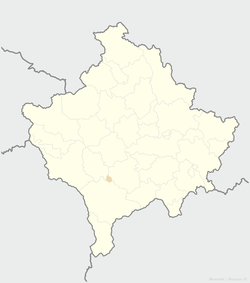Turkish population

The Turkish population refers to the number of ethnic Turkish people in the world.
During the Seljuk (1037–1194) and Ottoman (1299-1923) eras ethnic Turks were settled across the lands conquered by the two empires. In particular, the Turkification of Anatolia (modern Turkey) was the result of the Battle of Manzikert in 1077 and the formation of the Sultanate of Rum. Thereafter, the Ottomans continued Turkish expansion throughout the regions around the Black Sea and the Mediterranean Sea. Consequently, today the Turkish people form a majority in Turkey and Northern Cyprus. There are also significant Turkish minorities who still live in the Balkans, the Caucasus, and the Arab world.
More recently, the Turkish people have emigrated from their traditional areas of settlement for various reasons, forming a large diaspora. For example, from the mid-twentieth century onwards, unskilled mainland Turks settled mainly in German and French speaking countries of Western Europe as "guest workers"; in contrast, a "brain drain" of skilled workers migrated mostly to North America. Moreover, ethnic Turks from other traditional areas of settlement have emigrated mostly due to political reasons: the Meskhetian Turks were deported to Central Asia from Georgia in 1944 by the USSR authorities; Turkish Cypriots have emigrated mostly to the English-speaking world during the Cyprus conflict and its immediate aftermath.
Traditional areas of Turkish settlement
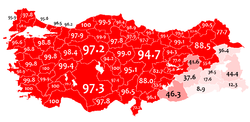
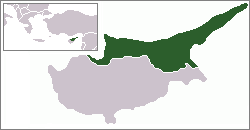
| Country | Official State census figures | Other estimates | Constitution recognition | See also |
|---|---|---|---|---|
| | N/A. The Turkish census collects data on country of birth but does not collect data on ethnicity. | 55,000,000 - 59,500,000[1][2] | The Turkish language is the official language of the Republic of Turkey, under Article 3 of the 1982 Turkish constitution. | Turkish people |
| | 1,128 (2011 Cypriot Census)[3] | 2,000 Turkish Cypriots remain in the internationally recognized southern region of the Republic of Cyprus.[4] | Under Article 2 of the Cypriot constitution the Turkish Cypriots, alongside the Greek Cypriots, form one of the two "Communities" in Cyprus. The Turkish Cypriots are therefore recognised as equal participants of the Republic rather than as a minority. Furthermore, under Article 3, the Greek and Turkish languages are the two official languages of Cyprus.[5] Despite President Makarios III's attempt to amend the constitution and the aim to weaken the rights of Turkish Cypriots, under the 1963 Akritas plan, the original 1960 constitution is still legally in force today. | Turkish Cypriots |
| | 286,257 (2011 Turkish Cypriot census)[6] | 300,000[7]-500,000[8] (includes Turkish Cypriots and recent Turkish settlers) | According to Article 2(2) of the 1985 constitution of the Turkish Republic of Northern Cyprus, which is only recognised by Turkey, the Turkish language is the sole official language of the break-away state.[9] | Turkish Cypriots |
Turkish minorities in the Balkans
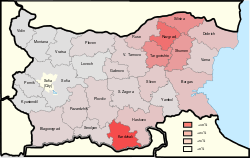
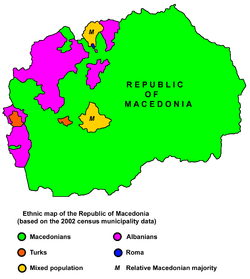
| Country | Official State census figures | Other estimates | Constitutional recognition/Minority status | Further information | Lists of Turks by country |
|---|---|---|---|---|---|
| | 267 (1991 Bosnian census)[10] | 50,000[11][12] | The Turkish language is officially recognized as a minority language, in accordance with the European Charter for Regional or Minority Languages, under Article 2, paragraph 2, of the 2010 ratification.[13] | Turks in Bosnia and Herzegovina | |
| | 588,318 (2011 Bulgarian census)[14] | 750,000[11] | The Bulgarian constitution of 1991 does not mention any ethnic minorities and the Bulgarian language is the sole official language of the State. However, in accordance with Article 36(2), the Turkish minority has the right to study their own language alongside the compulsory study of the Bulgarian language. Moreover, under Article 54(1), the Turkish minority have the right to "develop their culture in accordance with his ethnic identification".[15] | Turks in Bulgaria | List of Bulgarian Turks |
| | 367 (2011 Croatian census)[16] | 2,000[17] | The Turks are officially recognised as a minority ethnic group, in accordance with the 2010 Constitution of Croatia.[18] | Turks in Croatia | |
| | 179,895 (1951 Greek census)[19][20][21] | 150,000[11] (80,000[22] to 130,000 in Western Thrace,[23][24] 10,000[25] to 15,000 in Athens,[26] 5,000 in Rhodes and Kos,[27] and 5,000 in Thessaloniki)[26] | The Turks of Western Thrace have protected status to practice their religion and use the Turkish language, in accordance with the 1923 Treaty of Lausanne. However, the other sizeable Turkish minorities in Greece have no official recognition.[28] | Turks in Greece | |
| | 18,738 (2011 Kosovar census)[29] | 30,000[30] to 50,000[11] | The Turkish language is recognized as an official language in the municipalities of Prizren and Mamuša and has minority status in Gjilan, Pristina, Vučitrn, and Mitrovica.[31] | Turks in Kosovo | |
| | 77,959 (2002 Macedonian census)[32] | 170,000-200,000[33][34] | Initially the 1988 draft constitution spoke of the "state of the Macedonian people and the Albanian and Turkish minority". Once the 1991 constitution came into force the Turkish language was used officially where Turks formed a majority in the Centar Župa Municipality and the Plasnica Municipality. Since the 2001 amendment to the constitution, the Turkish language is officially used where Turks form at least 20% of the population and hence it is also an official language of Mavrovo and Rostuša.[35] | Turks in Macedonia | |
| | 104 (2011 Montenegrin census).[36] | Turks in Montenegro | |||
| | 28,226 (2011 Romanian census)[37] | 55,000[38] to 80,000[39] | The Turkish language is officially recognized as a minority language, in accordance with the European Charter for Regional or Minority Languages, under Part III of the 2007 ratification.[13] | Turks in Romania | |
| | 647 (2011 Serbian census)[40] | Turks in Serbia | |||
| Total | N/A | 1,300,000 (2011 estimate)[11] | Turks in the Balkans |
Turkish minorities in the Caucasus
Historical.svg.png)
| Country | Official State census figures | Other estimates | Constitutional recognition/ Minority status | Further information | Lists of Turks by country |
|---|---|---|---|---|---|
| | 731 (2011 Abkhazian census)[41] | 15,000[42] | Turks in Abkhazia | ||
| | Turkish minority N/A. Although the USSR censuses recorded a small number of Turks: 19 in 1970,[43] 28 in 1979,[44] and 13 in 1989,[45] they were not recorded in the 2001 Armenian census. | Turks in Armenia | |||
| | Turkish minority N/A. The 2009 Azeri census recorded 38,000 Turks;[46] however, it does not distinguish between the Turkish minority (descendants of Ottoman settlers who remained in Azerbaijan), Meskhetian Turks who arrived after 1944, and recent Turkish arrivals. | 19,000[47] (Descendants of Ottomans settlers who remained in Azerbaijan only. This does not include the much larger Meskhetian Turkish and mainland Turkish arrivals who form a part of the diaspora) | Turks in Azerbaijan | ||
| | *Pre-World War II: 137,921 (1926 USSR Census).[48] The Turkish population was not recorded in later censuses; nonetheless, it is estimated that 200,000 Turks from Meskheti were deported to Central Asia in 1944.[48] *Post-World War II: The Meskhetian Turkish population in the USSR was published for the first in the 1970 census. However, by this point, the Turkish minority in Georgia had already diminished to several hundred due to the forced deportation of 1944.[48] There were 853 Turks in Georgia in 1970,[43] 917 in 1979,[44] and 1,375 in 1989.[45] *Post-USSR: Although a small number has returned to Georgia, they have not been recorded in the 2002 Georgian census. | 1,500[49][50] | Meskhetian Turks | ||
Turkish minorities in the Arab World
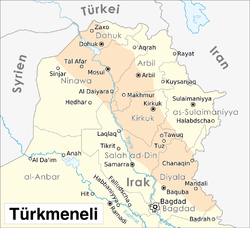
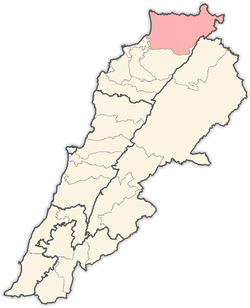
| Country | Official State census figures | Other estimates | Constitutional recognition/Minority status | Further information | Lists of Turks by country |
|---|---|---|---|---|---|
| | 600,000-3,300,000[51][52][53][54] | Turks in Algeria | |||
| | 100,000[55]-1,500,000[53][56] | Turks in Egypt | |||
| | 567,000 (1957 census) | 500,000–3,000,000[53][57] 3,000,000 (2013 Iraqi Ministry of Planning estimate)[58] | Under Article 14 of the draft of the first Iraqi constitution the Turks were one of the constitutive people of Iraq. However, due to the political dispute over the Mosul Question, which Turkey and Britain claimed as part of their territory, the Turkish minority in the Turkmeneli region were not mentioned in the 1925 and 1943 constitutions. Nevertheless, the 1932 Iraqi constitution was written in the Arabic, Kurdish and Turkish languages.[59] Under Article 3 of the current 2005 constitution the Iraqi Turks have been given official minority recognition. Furthermore, under Article 4, the Iraqi Turkmen/Turcoman language has been given official recognition.[60] Despite being called the "Turkmen/Turcoman" language, the Iraqi Turkoman Congress has adopted a Declaration of Principles, Article Three of which states that "The official written language of the Turkmans is Istanbul Turkish, and its alphabet is the new Latin alphabet."[61][62] | Iraqi Turkmensa[›] | |
| | 60,000[53] | Turks in Jordan | |||
| | 80,000[63] | Turks in Lebanon | |||
| | 50,000[53] | Turks in Libya | |||
| | 150,000[53] | Turks in Saudi Arabia | |||
| | 500,000-3,500,000[64][65][66][67][53][68] | Syrian Turkmens | |||
| | 500,000[53]-2,000,000[69] | Turks in Tunisia | |||
| | 10,000-30,000[70][71] | Turks in Yemen | |||
| Total | 8,760,000 (1993 estimate)[53] | ||||
Turkish diasporas
Central Asia
| Country | Official State census figures | Other estimates | Further information | Lists of Turks |
|---|---|---|---|---|
| | 97,015 (2009 Kazakh census)[72] | 150,000)[50]-180,000[49] (Meskhetian Turks only) | Turks in Kazakhstan | |
| | 39,133 (2009 Kyrgyz census)[73] | 50,000[74] to 70,000[75] (Meskhetian Turks only) | Turks in Kyrgyzstan | |
| | 1,360 (2010 Tajik census)[76] | Turks in Tajikistan | ||
| | 13,000 (2012 Turkmen census)[77] | Turks in Turkmenistan | ||
| | 106,302 (1989 Uzbek census)[78] | 15,000[79]-38,000[49][80] (Meskhetian Turks only) | Turks in Uzbekistan |
Europe
| Country | Official State census figures | Other estimates | Further information | Lists of Turks |
|---|---|---|---|---|
| | N/A. The Austrian census collects data on country of birth but does not collect data on ethnicity. | 350,000[81][82][83]-500,000[84][85] | Turks in Austria | List of Austrian Turks |
| | 38,000 (2009 Azeri census)[46] | 90,000-110,000 (Meskhetian Turks only)[50] | Turks in Azerbaijan | |
| | 55 (1989 Belarusian Census)[86] | |||
| | N/A. The Belgian census collects data on country of birth but does not collect data on ethnicity. | 200,000[87][88] to 250,000[89][90][91][92] | Turks in Belgium | List of Belgian Turks |
| | 1,700[93] | |||
| | N/A. The Danish census collects data on country of birth but does not collect data on ethnicity. | 70,000[94] 80,000[95] | Turks in Denmark | |
| | 544 (2011 Estonian census)[96] | |||
| | 10,000[97] | Turks in Finland | ||
| | N/A. The French census collects data on country of birth but does not collect data on ethnicity. | 800,000[98]- 1,000,000[99][100] | Turks in France | List of French Turks |
| | N/A. The German census collects data on country of birth and citizenship but does not collect data on ethnicity. | 3,500,000[101][102] 4,000,000 [103][104][105][106][107][108][109][110][111] 2,000 Turkish Cypriots[112] |
Turks in Germany | List of German Turks |
| | 1,565 (2001 Hungarian census)[113] | 2,500[114] | Turks in Hungary | |
| | 68[115] | |||
| | N/A. The Irish census collects data on country of birth but does not collect data on ethnicity. | 3,000[116] | Turks in Ireland | |
| | N/A. The Italian census collects data on country of birth but does not collect data on ethnicity. | 30,000-40,000[117][118] (excluding the Turkish minority in Moena) | Turks in Italy | |
| | 142[119] | lv:Turki Latvijā | ||
| | 1,000[120] | Turks in Liechtenstein | ||
| | 35[121] | |||
| | 450[122] | |||
| | 53[123] | |||
| | Turks in Moldova | |||
| | 57[124] | |||
| | N/A. The Dutch census collects data on country of birth but does not collect data on ethnicity. | 400,000-500,000[125] to 627,000[126] Plus 10,000-30,000 Bulgarian Turks.[127] | Turks in the Netherlands | List of Dutch Turks |
| | N/A. The Norwegian census collects data on country of birth but does not collect data on ethnicity. | 16,000[128] | Turks in Norway | |
| | 2,500[129] | Turks in Poland | ||
| | 250[130] | |||
| | Recorded 105,058 Turks and 4,825 Meskhetian Turks (2010 Russian census)[131] | 120,000-150,000[132] | Turks in Russia | |
| | 150[133] | |||
| | 259 (2002 Slovenian census)[134] | |||
| | N/A. The Spanish census collects data on country of birth but does not collect data on ethnicity. | 4,000[135] | Turks in Spain | |
| | N/A. The Swedish census collects data on country of birth but does not collect data on ethnicity. | 100,000[136][137]-200,000[138][139] Plus 30,000 Bulgarian Turks[140] | Turks in Sweden | |
| | N/A. The Swiss census collects data on country of birth but does not collect data on ethnicity. | 100,000[141]-120,000[142][143] | Turks in Switzerland | List of Swiss Turks |
| | Recorded 8,844 Turks and 336 Meskhetian Turks (2001 Ukrainian census)[144] | 10,000 (Meskhetian Turks only)[50] | Turks in Ukraine | |
| | N/A. The British census collects data on country of birth but does not collect data on ethnicity. | 500,000 (including 300,000-350,000 Turkish Cypriots)[145] | Turks in the United Kingdom | List of British Turks |
| Total | 9 to 10 million[11][146][147] | |||
North America
| Country | Official State census figures | Other estimates | Further information | Lists of Turks | |
|---|---|---|---|---|---|
| | 55,430 (2011 Canadian census)[148] | 100,000[149][150][151] Plus 1,800 Turkish Cypriots[112] | Turkish Canadians | List of Turkish Canadians | |
| | 206,911 (2014 American Community Survey estimate)[152] | 500,000[153][154] Plus 16,000 Meskhetian Turks[49] Plus 5,000 Turkish Cypriots[112] | Turkish Americans | List of Turkish Americans | |
Oceania
| Country | Official State census figures | Other estimates | Further information | Lists of Turks |
|---|---|---|---|---|
| | 66,919 (2011 census)[155] | 150,000[156] to 200,000[157] Plus 40,000-120,000 Turkish Cypriots[112][158][159][160] | Turkish Australians | List of Turkish Australians |
| | 957 (2013 census)[161] | 2,000-3,000[162] Plus 1,600 Turkish Cypriots[112] | Turks in New Zealand | |
Other regions
| Country | Official State census figures | Other estimates | Further information | Lists of Turks by country |
|---|---|---|---|---|
| | Turks in India came Directly from Turkey To delhi .They came for trade and for their old art work . | 100000[163] | Turks in India | |
| | 12,000[164] | |||
References and notes
- ↑ Milliyet. "55 milyon kişi 'etnik olarak' Türk". Retrieved 2015-11-22.
- ↑ CIA. "Turkey". Retrieved 2016-04-07.
- ↑ Republic of Cyprus Statistics Service. "Population Enumerated with Cypriot Citizenship, By Ethnic/Religious Group, Age and Sex (1.10.2001)". Retrieved 2016-04-26.
- ↑ Hatay, Mete (2007), Is the Turkish Cypriot Population Shrinking? (PDF), http://www.prio.no/: International Peace Research Institute, p. 40, ISBN 978-82-7288-244-9
- ↑ Presidency of the Republic of Cyprus. "The Constitution of the Republic of Cyprus" (PDF). Retrieved 2016-04-26.
- ↑ TRNC State Planning Organization (2011). "Nüfus ve Konut Sayımı" (PDF). National Statistical Institute of Bulgaria. p. 4.
- ↑ International Crisis Group (2010). "CYPRUS: BRIDGING THE PROPERTY DIVIDE". International Crisis Group. p. 2.
- ↑ Cole 2011, 95.
- ↑ Embargoed. "The Constitution of the Turkish Republic of Northern Cyprus" (PDF). Retrieved 2016-04-26.
- ↑ Federal Office of Statistics. "Population grouped according to ethnicity, by censuses 1961-1991". Retrieved 2011-10-16.
- 1 2 3 4 5 6 Cole, Jeffrey (2011), Ethnic Groups of Europe: An Encyclopedia, ABC-CLIO, pp. 367–368, ISBN 1-59884-302-8,
Today Turkish/Muslim populations residing in the former European Turkey approximately amounts to 1.3 million, with roughly 50,000 in Bosnia- Herzegovina, 50,000 in Kosovo, 55,000 in Romania, 150,000 in Greece, 200,000 in the Republic of Macedonia, 750,000 in Bulgaria, and the rest living in various Balkan countries. This estimate does not included those citizens of Turkey who work and reside in the Balkans...
- ↑ Minahan, James (1998), Miniature Empires: A Historical Dictionary of the Newly Independent States, Greenwood Publishing Group, p. 45, ISBN 0313306109
- 1 2 Council of Europe. "List of declarations made with respect to treaty No. 148". Retrieved 2013-12-21.
- ↑ Национален статистически институт. "Население по местоживеене, възраст и етническа група1" (in Bulgarian). Retrieved 2015-11-22.
- ↑ Schwartz, Herman (2002), The Struggle for Constitutional Justice in Post-Communist Europe, University of Chicago Press, p. 184, ISBN 0226741966
- ↑ "Stanovništvo prema narodnosti, popisi 1971. - 2011." (in Croatian). Retrieved 2015-11-22.
- ↑ Zaman. "Altepe'den Hırvat Müslümanlara moral". Retrieved 2011-09-09.
- ↑ Anita Skelin Horvat. "Language Policy in Istria, Croatia –Legislation Regarding Minority Language Use" (PDF) (in Bulgarian). p. 51. Retrieved 2015-11-22.
- ↑ Ortakovski, Vladimir (2000), Minorities in the Balkans, Transnational Publishers, p. 187, ISBN 1571051295
- ↑ Clogg, Richard (2002), Minorities in Greece: Aspects of a Plural Society, C. Hurst & Co. Publishers, p. xi, ISBN 185065705X
- ↑ Trudgill, Peter; Schreier, Daniel (2006), "Greece and Cyprus / Griechenland und Zypern", in Ulrich, Ammon, Sociolinguistics / Soziolinguistik, Walter de Gruyter, p. 1885, ISBN 3110199874
- ↑ "Demographics of Greece". European Union National Languages. Retrieved 19 December 2010.
- ↑ Western Thrace Minority University Graduates Association (2009), Western Thrace Turkish Minority (PDF), http://www.pekem.org/: Culture and Education Foundation of Western Thrace Minority, p. 2
- ↑ Ergener, Rashid; Ergener, Resit (2002), About Turkey: Geography, Economy, Politics, Religion, and Culture, Pilgrims Process, p. 106, ISBN 0-9710609-6-7
- ↑ Madianou, Mirca (2005), Mediating the nation: news, audiences and the politics of identity, Routledge Cavendish, pp. 36–37, ISBN 1-84472-028-4
- 1 2 Pettifer, James; Nazarko, Mentor (2007), Strengthening Religious Tolerance for a Secure Civil Society in Albania and the Southern Balkans, IOS Press, p. 68, ISBN 1-58603-779-X
- ↑ Clogg, Richard (2002), Minorities in Greece, Hurst & Co. Publishers, p. 84, ISBN 1-85065-706-8
- ↑ Trudgill & Schreier, 2006 p.1886.
- ↑ European Centre for Minority Issues Kosovo. "Minority Communities in the 2011 Kosovo Census Results: Analysis and Recommendations" (PDF). p. 4. Retrieved 2015-11-22.
- ↑ OSCE (2010), "Community Profile: Kosovo Turks", Kosovo Communities Profile, Organization for Security and Co-operation in Europe, p. 3.
- ↑ European Centre for Minority Issues Kosovo. "Community Profile: Turkish Community" (PDF). p. 2. Retrieved 2016-04-07.
- ↑ Republic of Macedonia State Statistical Office (2005), Census of Population, Households and Dwellings in the Republic of Macedonia, 2002 (PDF), Republic of Macedonia — State Statistical Office, p. 34
- ↑ Knowlton, MaryLee (2005), Macedonia, Marshall Cavendish, p. 66, ISBN 0-7614-1854-7
- ↑ Abrahams, Fred (1996), A Threat to "Stability": Human Rights Violations in Macedonia, Human Rights Watch, p. 53, ISBN 1-56432-170-3
- ↑ Dzankic, Jelena (2016), Citizenship in Bosnia and Herzegovina, Macedonia and Montenegro: Effects of Statehood and Identity Challenges, Routledge, p. 81, ISBN 1317165799
- ↑ Statistical Office of Montenegro. "Population of Montenegro by sex, type of settlement, etnicity, religion and mother tongue, per municipalities" (PDF). p. 7. Retrieved 21 September 2011.
- ↑ National Institute of Statistics (2011), Comunicat de presă privind rezultatele provizorii ale Recensământului Populaţiei şi Locuinţelor – 2011 (PDF), Romania-National Institute of Statistics, p. 10
- ↑ Phinnemore, David (2006), The EU and Romania: accession and beyond, The Federal Trust for Education & Research, p. 157, ISBN 1-903403-78-2
- ↑ Constantin, Daniela L.; Goschin, Zizi; Dragusin, Mariana (2008), "Ethnic entrepreneurship as an integration factor in civil society and a gate to religious tolerance. A spotlight on Turkish entrepreneurs in Romania", Journal for the Study of Religions and Ideologies, 7 (20): 59
- ↑ Попис становништва, домаћинстава и станова 2011. у Републици Србији: Становништво према националној припадности - „Oстали“ етничке заједнице са мање од 2000 припадника и двојако изјашњени
- ↑ "Abkhazia Population Censuses (1886-2011)". Retrieved 2015-11-22.
- ↑ Bul Turk. "Abhazya'da Yaşayan Osmanlı Türkleri ilgi bekliyor". Retrieved 2010-05-12.
- 1 2 Демоскоп Weekly. "Всесоюзная перепись населения 1970 года. Национальный состав населения по республикам СССР". Retrieved 2009-11-10.
- 1 2 Демоскоп Weekly. "Всесоюзная перепись населения 1979 года. Национальный состав населения по республикам СССР". Retrieved 2009-11-10.
- 1 2 Демоскоп Weekly. "Всесоюзная перепись населения 1989 года. Национальный состав населения по республикам СССР". Retrieved 2009-11-10.
- 1 2 The State Statistical Committee of the Republic of Azerbaijan. "Population by ethnic groups". Retrieved 2012-01-16.
- ↑ Minahan, James (1998), Miniature Empires: A Historical Dictionary of the Newly Independent States, Greenwood Publishing Group, p. 19, ISBN 0313306109,
...numbering about 19,000. The Turks are the remnant of a larger Turkish population that has mostly assimilated into Azeri culture since the seventeenth century, aided by the similarity between the Turkish and Azeri languages and cultures. Many of the Turks came to the region when Azerbaijan formed part of the Turkish Ottoman Empire. Unlike the majority of the Azeris, the Turks are mostly Sunni Muslim.
- 1 2 3 Zisserman-Brodsky, Dina (2003), "The Relevant Nationalities-Basic Facts", Constructing Ethnopolitics in the Soviet Union: Samizdat, Deprivation and the Rise of Ethnic Nationalism, Pelgrave Macmillan, p. 214, ISBN 1403973628
- 1 2 3 4 Al Jazeera (2014). "Ahıska Türklerinin 70 yıllık sürgünü". Al Jazeera. Retrieved 2016-07-05.
- 1 2 3 4 Aydıngün, Ayşegül; Harding, Çiğdem Balım; Hoover, Matthew; Kuznetsov, Igor; Swerdlow, Steve (2006), Meskhetian Turks: An Introduction to their History, Culture, and Resettlement Experiences (PDF), http://www.cal.org/: Center for Applied Linguistics, pp. 13–14
- ↑ Turkish Embassy in Algeria (2008), Cezayir Ülke Raporu 2008, Ministry of Foreign Affairs, p. 4
- ↑ Oxford Business Group (2008), The Report: Algeria 2008, Oxford Business Group, p. 10, ISBN 1-902339-09-6
- 1 2 3 4 5 6 7 8 9 Akar, Metin (1993), "Fas Arapçasında Osmanlı Türkçesinden Alınmış Kelimeler", Türklük Araştırmaları Dergisi, 7: 94–95
- ↑ Zaman. "Türk'ün Cezayir'deki lakabı: Hıyarunnas!". Retrieved 2012-03-18.
- ↑ Baedeker, Karl (2000), Egypt, Elibron, p. lviii, ISBN 1-4021-9705-5
- ↑ Nkrumah, Gamal (2016). "Did the Turks sweeten Egypt's kitty?". Al-Ahram Weekly. Retrieved 30 October 2016.
Today, the number of ethnic Turks in Egypt varies considerably, with estimates ranging from 100,000 to 1,500,000. Most have intermingled in Egyptian society and are almost indistinguishable from non-Turkish Egyptians, even though a considerable number of Egyptians of Turkish origin are bilingual.
- ↑ Park, Bill (2005), Turkey's policy towards northern Iraq: problems and perspectives, Taylor & Francis, p. 36, ISBN 0-415-38297-1
- ↑ Bassem, Wassim (2016). "Iraq's Turkmens call for independent province". Al-Monitor.
Turkmens are a mix of Sunnis and Shiites and are the third-largest ethnicity in Iraq after Arabs and Kurds, numbering about 3 million out of the total population of about 34.7 million, according to 2013 data from the Iraqi Ministry of Planning.
- ↑ Ezzat, Yawooz (2012), The Treatment of Iraqi Turks Since the Aftermath of WWI: A Human Rights Perspective, Trafford Publishing, pp. 61–62, ISBN 0313306109
- ↑ Ezzat, 2013 p.23.
- ↑ Türkmeneli İşbirliği ve Kültür Vakfı. "Declaration of Principles of the (Iraqi?) Turkman Congress". Retrieved 2011-11-25.
- ↑ Nissman, David (5 March 1999), "The Iraqi Turkomans: Who They Are and What They Want", Iraq Report, Radio Free Europe/Radio Liberty, 2 (9)
- ↑ Al-Akhbar. "Lebanese Turks Seek Political and Social Recognition". Retrieved 2012-03-02.
- ↑ Enab Baladi (2015). "تركمان سوريا والعودة إلى الجذور".
رغم غياب الإحصائيات الدقيقة لأعداد التركمان في سوريا، إلى أن أعدادهم تقدر ما بين 750 ألف إلى مليون ونصف تركماني، يتركز معظمهم في المناطق الشمالية مثل حلب، اللاذقية، حمص وحماة، بالإضافة إلى دمشق.
- ↑ BBC Arabic (2015). "من هم التركمان في سوريا ؟".
وليست هناك إحصائيات دقيقة عن عدد التركمان ، لكن يقدر عددهم بين 1.5 إلى 3.5 مليون .
- ↑ Hamud, Salman Falah (2015), مركبات الشعب السوري, Al-Amama,
المجموعة الخامسة في سورية، نسبة\ا الأتراك وبشكل تقريبي 3% ~ 7% من تعداد سكّان سورية، ينتشر التركمان في ستّ محافظات سوريّة: حمص وحماة ودمشق وحلب واللاذقيّة والقنيطرة (الجولان)، ينقسم التركمان في سورية عرقيّاً وثقافيّاً إلى قسمين: أتراك المدن وأتراك الأرياف.
- ↑ BBC (2015). "Who are the Turkmen in Syria?".
There are no reliable population figures, but they are estimated to number between about half a million and 3.5 million.
- ↑ Özkaya, Abdi Noyan (2007), "Suriye Kürtleri: Siyasi Etkisizlik ve Suriye Devleti'nin Politikaları" (PDF), Review of International Law and Politics, 2 (8): 112, retrieved 2010-09-10
- ↑ Haftaya Bakış (6), Bakış Basın Yayın Organizasyon, 1998, p. 35.
- ↑ Türkiye Cumhuriyeti Cumhurbaşkanlığı. "Cumhurbaşkanı Gül, Türkiye-Yemen İş Forumu'nda". Retrieved 2011-05-12.
- ↑ Star Gazete. "Yemen Mecnun'u çöllere düşüren büyülü ülke". Retrieved 2011-05-12.
- ↑ Агентство РК по статистике. "ПЕРЕПИСЬ НАСЕЛЕНИЯ РЕСПУБЛИКИ КАЗАХСТАН 2009 ГОДА" (PDF). p. 10. Retrieved 2011-02-13.
- ↑ Population and Housing Census 2009. Book 2. Part 1. (in tables). Population of Kyrgyzstan. (Перепись населения и жилищного фонда Кыргызской Республики 2009. Книга 2. Часть 1. (в таблицах). Население Кыргызстана) (PDF), Bishkek: National Committee on Statistics, 2010
- ↑ IRIN Asia. "KYRGYZSTAN: Focus on Mesketian Turks". Retrieved 2009-10-15.
- ↑ Blacklock 2005, 10.
- ↑ Taj Stat. "БАРӮЙХАТГИРИИ АҲОЛӢ ВА ФОНДИ МАНЗИЛИ ҶУМҲУРИИ ТОҶИКИСТОН ДАР СОЛИ 2010 Перепись населения и жилищного фонда Республики Таджикистан 2010 года" (PDF). p. 59. Retrieved 2016-05-28. line feed character in
|title=at position 37 (help) - ↑ Asgabat. "Национальный и религиозный состав населения Туркменистана сегодня". Retrieved 2016-05-27.
- ↑ Демоскоп Weekly. "Всесоюзная перепись населения 1989 года. Национальный состав населения по республикам СССР". Retrieved 2009-11-10.
- ↑ Aydıngün, Ayşegül; Harding, Çigğdem Balım; Hoover, Matthew; Kuznetsov, Igor; Swerdlow, Steve (2006), Meskhetian Turks: An Introduction to their History, Culture, and Resettelment Experiences (PDF), Center for Applied Linguistics, p. 23
- ↑ Blacklock, Denika (2005), Finding Durable Solutions for the Meskhetians (PDF), European Centre for Minority Issues, p. 8
- ↑ BBC (2010-11-10). "Turkey's ambassador to Austria prompts immigration spat". BBC News. Retrieved 2010-11-10.
- ↑ Avrupa Türk-İslam Birliği. "Avusturya Türk İslam Kültür ve Sosyal Yardımlaşma Birliği:Sosyal Hayat ve Dini Yapı". Retrieved 2010-11-13.
- ↑ Yakın Dünya. "Türkiye'nin Avusturya Büyükelçisi Göçmen Meselesini Gündeme Getirdi". Retrieved 2010-11-13.
- ↑ Andreas Mölzer. "In Österreich leben geschätzte 500.000 Türken, aber kaum mehr als 10–12.000 Slowenen". Retrieved 2011-10-16.
- ↑ Juedische-Allgemeine. "Erheblicher Anstieg antisemitischer Vorfälle in Wien". Retrieved 2010-11-13.
- ↑ Демоскоп Weekly. "Всесоюзная перепись населения 1989 года. Национальный состав населения по республикам СССР". Retrieved 2009-11-10.
- ↑ King Baudouin Foundation (2008), Turkish communities and the EU (PDF), http://www.kbs-frb.be/: King Baudouin Foundation, p. 5
- ↑ Kaya, Ayhan; Kentel, Ferhat (2007), Belgian-Turks A Bridge or a Breach between Turkey and the European Union? (PDF), http://www.kbs-frb.be/: King Baudouin Foundation, p. 27, ISBN 978-90-5130-587-6.
- ↑ http://www.gundem.be/tr/belcika/milletvekili-veli-yuksel-hamme-camii-yardimlasma-gecesine-katildi
- ↑ http://www.lokum.nl/turk-wilde-geen-schotelantenne-op-dak/
- ↑ http://www.afyonkarahisar.com.tr/haberdetay.asp?id=47065
- ↑ http://www.tumgazeteler.com/?a=6575661
- ↑ Rep. of Turkey Ministry of Foreign Affairs. "Turkey's Political Relations with Czech Republic". Retrieved 2010-06-03.
- ↑ DR Online. "Tyrkisk afstand fra Islamisk Trossamfund". Retrieved 2010-06-03.
- ↑ http://www.haber.dk/eskihaber/sayilar/201104.pdf
- ↑ Eesti Statistika 2008. "PC0436: POPULATION, 31. DECEMBER 2011 by Place of residence, Command of foreign languages, Sex and Mother tongue". Retrieved 2016-07-01.
- ↑ Svensk-Turkiska Riksförbundet. "Diyanet İskandinavya'nın en uç noktası Finlandiya'da". Retrieved 2012-03-16.
- ↑ Zaman France. "La communauté turque compte 611.515 personnes en France". Retrieved 2014-12-21.
- ↑ http://www2.dha.com.tr/haberdetay.asp?Newsid=217705
- ↑ Fransa Diyanet İşleri Türk İslam Birliği. "2011 YILI DİTİB KADIN KOLLARI GENEL TOPLANTISI PARİS DİTİB'DE YAPILDI". Retrieved 2012-02-15.
- ↑ Spiegel. "Nach Armenien-Resolution: Deutsch-türkische Abgeordnete bekommen mehr Polizeischutz". Retrieved 2016-08-09.
Innenminister Thomas de Maizière sagte dem Blatt: "Die Bedrohungen gegen türkischstämmige Abgeordnete sind nicht zu akzeptieren." Selbstverständlich würden - wenn erforderlich - die Sicherheitsmaßnahmen angepasst. Die meisten der 3,5 Millionen Menschen mit türkischen Wurzeln in Deutschland seien aber gute Nachbarn. "Die Straftäter und Extremisten sind Einzelfälle", sagte der CDU-Politiker.
- ↑ The Local. "'Learn the language,' Turkish minister tells countrymen in Germany". Retrieved 2010-10-28.
- ↑ Kötter, I; Vonthein, R; Günaydin, I; Müller, C; Kanz, L; Zierhut, M; Stübiger, N (2003), "Behçet's Disease in Patients of German and Turkish Origin- A Comparative Study", in Zouboulis, Christos (ed), Advances in Experimental Medicine and Biology, Volume 528, Springer, p. 55, ISBN 0-306-47757-2,
Today, more than 4 million people of Turkish origin are living in Germany.
- ↑ Fischer, Tristan (2015), History Future Now, Lulu Press, p. 122, ISBN 132970746X,
By 2012 over 4 million people, around 5% of the German population, were of Turkish descent.
- ↑ Rizvi, Kishwar (2015), The Transnational Mosque: Architecture and Historical Memory in the Contemporary Middle East, University of North Carolina Press, p. 36, ISBN 1469621177,
...at least 4 million people of Turkish descent living in Germany.
- ↑ Audretsch, David B.; Lehmann, Erik E. (2016), The Seven Secrets of Germany: Economic Resilience in an Era of Global Turbulence, Oxford University Press, p. 130, ISBN 0190258691,
By 2010 the number of Turkish descent living in Germany had increased to four million.
- ↑ Weaver-Hightower, Rebecca (2014), "Introduction", in Weaver-Hightower, Rebecca; Hulme, Peter, Postcolonial Film: History, Empire, Resistance, Routledge, p. 13, ISBN 1134747276,
By the end of the first decade of the twenty-first century there were around four million people of Turkish descent living in Germany...
- ↑ Volkan, Vamik D. (2014), Enemies on the Couch: A Psychopolitical Journey Through War and Peace, Pitchstone Publishing, ISBN 1939578116,
Today, for example, it is estimated that more than four million Turks and German citizens with part of full Turkish ancestry live in Germany alone.
- ↑ Temel, Bülent (2013), "Candidacy versus Membershop: Is Turkey the Greatest Beneficiary of the European Union?", The Great Catalyst: European Union Project and Lessons from Greece and Turkey, Lexington Books, p. 345, ISBN 0739174495,
Today, there are nearly four million people with Turkish ancestry in Germany, which makes them the largest minority in Germany (5 percent of 82 million people).
- ↑ Fernández-Kelly, Patricia (2015), "Assimilation through Transnationalism: A Theoretical Synthesis", in Portes, Alejandro; Fernández-Kelly, Patricia, The State and the Grassroots: Immigrant Transnational Organizations in Four Continents, Berghahn Books, p. 305, ISBN 1782387358,
Nearly fifty years later, close to four million Turks and their children continue to reside in the margins of German society
- ↑ Taras, Raymond (2015), ""Islamophobia never stands still": race, religion, and culture", in Nasar, Meer, Racialization and Religion: Race, Culture and Difference in the Study of Antisemitism and Islamophobia, Routledge, p. 46, ISBN 1317432444,
...about four million Turks are thought to live in Germany.
- 1 2 3 4 5 Star Kıbrıs. "'Sözünüzü Tutun'". Retrieved 10 September 2012.
- ↑ Hungarian Central Statistical Office. "Factors of the nationality of the population based on affiliation with cultural values, knowledge of languages". Retrieved 2013-05-21.
- ↑ Hurriyet. "Macaristan Türk yatırımcı bekliyor". Retrieved 2016-06-22.
- ↑ Statistics Iceland. "Population by origin, citizenship and country of birth". Retrieved 2010-06-03.
- ↑ Lacey, Jonathan (2007), Exploring the Transnational Engagements of a Turkic Religio-Cultural Community in Ireland (PDF), http://www.translocations.ie/, p. 2
- ↑ Çakırer, Yasemin (2009), "Göç Trafiğinde Araftakiler: İtalya'daki Türkler", in Erdoğan, Murat, Yurtdışındaki Türkler: 50. Yılında Göç ve Uyum, Orion Kitabevi, p. 763, ISBN 978-9944-769-53-2
- ↑ "İtalya'da Türkçe Öğrenimine Talep". Haberler. 3 February 2015. Retrieved 2015-11-22.
- ↑ PMLP. "Latvijas iedzivotaju sadalijums pec nacionala sastava un valstiskas piederibas" (PDF). Retrieved 2011-03-05.
- ↑ Fürstentum Liechtenstein (2007), Liechtenstein-Turkey (PDF), http://www.liechtenstein.li/en/: Fürstentum Liechtenstein, p. 6
- ↑ Statistics Lithuania RSS. "Population by place of birth and sex". Retrieved 2010-06-03.
- ↑ du Grand-Duché de Luxembourg. "Etat civil et population du Luxembourg: Ventilation par nationalité du répertoire". Retrieved 2010-06-03.
- ↑ Amore, Katia (2005), Active Civic Participation of Immigrants in Malta (PDF), http://www.politis-europe.uni-oldenburg.de/: Retrieved on September 4th 2009, p. 15
- ↑ Kettani, Houssain (2014). The World Muslim Population, History & Prospect. Singapore: Research Publishing Service. p. 4. ISBN 978-981-07-7244-4..
- ↑ Türkiye Büyük Millet Meclisi (2009), İnsan Haklarını İnceleme Komisyonu: Fransa Raporu (PDF), http://www.tbmm.gov.tr/: Grand National Assembly of Turkey, p. 11
- ↑ http://www.sabah.com.tr/Ekonomi/2011/11/15/90-ulkeden-2-bin-turk-isadami-geliyor
- ↑ TheSophiaEcho. "Turkish Bulgarians fastest-growing group of immigrants in the Netherlands". Retrieved 2009-07-26.
- ↑ Statistics Norway. "Persons with immigrant background by immigration category and country background 1 January 2010". Retrieved 2010-06-03.
- ↑ Rep. of Turkey Ministry of Foreign Affairs. "Turkey's Political Relations with Poland". Retrieved 2010-06-03.
- ↑ Rep. of Turkey Ministry of Foreign Affairs. "Turkey's Political Relations with Portugal". Retrieved 2010-06-03.
- ↑ Демоскоп Weekly. "Всероссийская перепись населения 2010 г. Национальный состав населения Российской Федерации". Retrieved 2012-01-30.
- ↑ Ryazantsev, Sergey V. (2009), "Turkish Communities in the Russian Federation" (PDF), International Journal on Multicultural Societies, 11 (2): 159.
- ↑ Statistical Office of the Slovak Republic. "Long-term immigration by country of last residence and age in 2006". Retrieved 2010-06-03.
- ↑ Statistical Office Of The Republic Of Slovenia. "Population by ethnic affiliation, Slovenia, Census 1953, 1961, 1971, 1981, 1991 and 2002". Retrieved 2010-06-03.
- ↑ Hürriyet Daily News. "Turkey 'more democratic' under Erdoğan, says Spanish Muslim leader". Retrieved 2010-07-14.
- ↑ Swedish International Development Cooperation Agency. "Turkiet är en viktig bro mellan Öst och Väst". Retrieved 2011-04-14.
- ↑ Swedish Ministry for Foreign Affairs. "Ankara Historia". Retrieved 2011-04-14.
- ↑ "Gurbetçiler İsveç'te Türk Bankası İstiyor". Haberler. 27 August 2012. Retrieved 2015-11-22.
- ↑ Hava, Ergin (15 April 2011). "Swedish trade minister Ewa Björling calls on Turkey to cooperate in third countries". Sundays Zaman. Retrieved 15 April 2011.
- ↑ Laczko, Frank; Stacher, Irene; Klekowski von Koppenfels, Amanda (2002), New challenges for Migration Policy in Central and Eastern Europe, Cambridge University Press, p. 187, ISBN 90-6704-153-X
- ↑ The Federal Authorities of the Swiss Confederation. "Bilateral relations between Switzerland and Turkey". Retrieved 2010-06-03.
- ↑ The Federal Authorities of the Swiss Confederation. "Diaspora und Migrantengemeinschaften aus der Türkei in der Schweiz" (PDF). Retrieved 2008-12-16.
- ↑ Türkische Gemeinschaft Schweiz. "VERANSTALTUNGEN - PROJEKTE". Retrieved 2011-02-09.
- ↑ State Statistics Service of Ukraine. "Ukrainian Census (2001):The distribution of the population by nationality and mother tongue". Retrieved 2015-11-22.
- ↑ Home Affairs Committee (2011), Implications for the Justice and Home Affairs area of the accession of Turkey to the European Union (PDF), The Stationery Office, p. 38, ISBN 0-215-56114-7
- ↑ Pashayan, Araks (2012), "Integration of Muslims in Europe and the Gülen", in Weller, Paul; Ihsan, Yilmaz, European Muslims, Civility and Public Life: Perspectives On and From the Gülen Movement, Continuuum International Publishing Group, ISBN 1-4411-0207-8
- ↑ Debating Europe. "Arguments for and against Turkey's EU membership". Retrieved 2015-11-22.
- ↑ Statistics Canada. "2011 National Household Survey: Data tables". Retrieved 11 February 2014.
- ↑ Canada Turk. "Türkiye'den evlenmek şart mı?". Retrieved 2011-07-12.
- ↑ Zaman. "Buyurun Kanada'ya uçalım". Retrieved 2011-09-27.
- ↑ http://www.yolcuturk.com/0,375-air,canada,ve,thy,duellosu.html
- ↑ U.S. Census Bureau. "TOTAL ANCESTRY REPORTED Universe: Total ancestry categories tallied for people with one or more ancestry categories reported 2014 American Community Survey 1-Year Estimates". Retrieved 2012-10-03.
- ↑ Grabowski, John J. (2005). "TURKS IN CLEVELAND - The Encyclopedia of Cleveland History". Encyclopedia of Cleveland History. Retrieved 2012-10-03.
- ↑ Assaker, Rima (2012). "Census Takes Aim to Tally 'Hard to Count' Populations". The Washington Diplomat. Retrieved 2012-10-03.
- ↑ Australian Bureau of Statistics. "Community Information Summary" (PDF). Retrieved 2016-04-06.
- ↑ "Old foes, new friends". Sydney Morning Herald. 2005-04-23. Retrieved 2008-12-26.
- ↑ http://www.milliyet.com.tr/Dunya/SonDakika.aspx?aType=SonDakika&ArticleID=1094744&Date=14.05.2009&Kategori=dunya&b=Avustralyali%20Turklerden,%20TRT%20Turke%20tepki
- ↑ TRNC Ministry of Foreign Affairs. "Briefing Notes on the Cyprus Issue". Retrieved 2010-10-03.
- ↑ Kibris Gazetesi. "Avustralya'daki Kıbrıslı Türkler ve Temsilcilik...". Retrieved 2011-05-31.
- ↑ BRT. "AVUSTURALYA'DA KIBRS TÜRKÜNÜN SESİ". Retrieved 2011-07-18.
- ↑ Statistics New Zealand. "2013 Census ethnic group profiles: Turkish". Retrieved 2016-04-07. line feed character in
|title=at position 35 (help) - ↑ Pearl of the Islands. "How many Turks living in New Zealand?". Retrieved 2008-10-29.
- ↑ Mehmet Ozkan (2010). "Can the Rise of 'New' Turkey Lead to a 'New' Era in India-Turkey Relations?" (PDF). New Delhi: Institute for Defence Studies & Analyses. p. 10.
- ↑ Minority migrant groups in Peru, Turks in Peru.
Bibliography
- Akgündüz, Ahmet (2008), Labour migration from Turkey to Western Europe, 1960-1974: A multidisciplinary analysis, Ashgate Publishing, ISBN 0-7546-7390-1.
- Blagojević, Gordana (2007), Recent Turkish Migrants in Serbia and the Role of the Serbian-Turkish Friendship Association (PDF), Ethnographic Institute of the SASA, Belgrade.
- Cole, Jeffrey (2011), Ethnic Groups of Europe: An Encyclopedia, ABC-CLIO, ISBN 1-59884-302-8.
- Federation of Turkish Associations in the UK (2008), BRIEF HISTORY OF THE FEDERATION OF TURKISH ASSOCIATIONS IN UK, http://www.turkishfederationuk.com/: Federation of Turkish Associations in the UK
- Extra, Guus; Gorter, Durk (2001), The other languages of Europe: demographic, sociolinguistic, and educational perspectives, Multilingual Matters, ISBN 1-85359-509-8.
- Hunter, Shireen (2002), Islam, Europe's second religion: the new social, cultural, and political landscape, Greenwood Publishing Group, ISBN 0-275-97609-2.
- Karpat, Kemal H. (2002), Studies on Ottoman social and political history: selected articles and essays, BRILL, ISBN 90-04-12101-3.
- Karpat, Kemal H. (2004), Studies on Turkish Politics and Society: Selected Articles and Essays:Volume 94 of Social, economic, and political studies of the Middle East, BRILL, ISBN 90-04-13322-4.
- Kasaba, Reşat (2008), The Cambridge History of Turkey: Turkey in the Modern World, Cambridge University Press, ISBN 0-521-62096-1.
- Kaya, Ayhan; Kentel, Ferhat (2004), Euro-Turks: A Bridge, or a Breach, between Turkey and the European Union? (PDF), http://www.osce.org/: Istanbul Bilgi University
- Kibaroğlu, Mustafa; Kibaroğlu, Ayșegül; Halman, Talât Sait (2009). Global security watch Turkey: A reference handbook. Greenwood Publishing Group. ISBN 0-313-34560-0..
- Oustinova-Stjepanovic, Galina (2008), Religion and Politics of Sufi Turks in Macedonia A pre-field proposal (PDF), http://www.ucl.ac.uk/: University College London
- Scherrer, Christian P. (2003), Ethnicity, nationalism, and violence: conflict management, human rights, and multilateral regimes, Ashgate Publishing, ISBN 0-7546-0956-1.
- Taylor, Scott (2004), Among the Others: Encounters with the Forgotten Turkmen of Iraq, Esprit de Corps Books, ISBN 1-895896-26-6
- TRNC PRIME MINISTRY STATE PLANNING ORGANIZATION (2006), TRNC GENERAL POPULATION AND HOUSING UNIT CENSUS (PDF), http://www.pekem.org/: TRNC PRIME MINISTRY STATE PLANNING ORGANIZATION
- Turkish Embassy in Algeria (2008), Cezayir Ülke Raporu 2008, Ministry of Foreign Affairs.
- Twigg, Stephen; Schaefer, Sarah; Austin, Greg; Parker, Kate (2005), Turks in Europe: Why are we afraid? (PDF), http://fpc.org.uk/: The Foreign Policy Centre, ISBN 1903558794
- Vachudová, Milada Anna (2005), Europe Undivided: Democracy, Leverage, and Integration After Communism, Oxford University Press, ISBN 0-19-924119-8
- Warrander, Gail; Knaus, Verena (2008), Bradt Travel Guide Kosovo, Springer, ISBN 0-306-47757-2.
